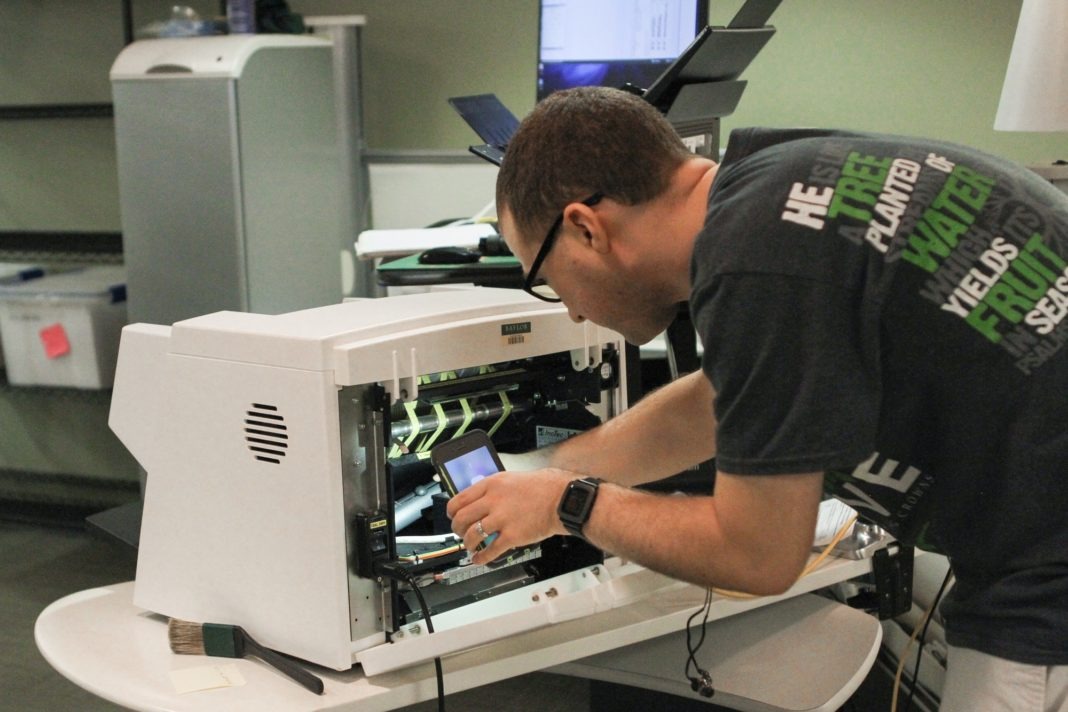Baylor digitizes, preserves history
Access this article on the Baylor Lariat website here.
Behind students studying for upcoming exams on the garden level of the Moody Memorial Library, the Ray I. Riley Digitization Center contains machines that are processing and preserving history.
The center houses the Digital Preservation Services team’s technology and offices where they digitize and preserve mediums such as film, music and text.
Darryl Stuhr, assistant director for digital projects, said the goal is not only to digitize physical resources to be shared online, but also to preserve their information.
“We want to be able to capture the essence of what’s on these deteriorating physical materials and save it decades, hundred years from now,” Stuhr said.
The preservation services maintains physical materials for Baylor’s libraries, such as the Armstrong Browning Library, and archives, such as the collections at the Institute for Oral History, some of which are up to 100 years old.
“Our first project was the digitization of their oral history transcripts, so all of their transcripts were bound transcripts that were created on a typewriter,” Stuhr said.
Travis Taylor, an academic consultant and digitization specialist for Digital Preservation Services, utilizes the newest addition to the center’s resources — a film scanner — to digitize the footage of Baylor football and basketball games.
In order to digitize film before the new film scanner, any film materials had to be outsourced.
“[Now,] we can actually digitize it in-house as opposed to outsourcing it to someone else,” Taylor said. “Which is always preferable because that way we don’t have to ship the material or trust someone else to handle it.”
Many of their other resources are scanners that range in different shapes and sizes, including an automatic page-turning scanner.

“While the majority of our work is digitizing library and archival materials that’s on campus, we also have special projects,” Stuhr said.
One of the special projects is the Black Gospel Music Restoration Project that they have been working with Robert Darden, professor of the journalism department, for over 10 years. They record music from records in a sound isolation booth.
“The idea is to get as isolated of a signal as possible, so to do that we have to digitize it in a sound isolation booth,” Taylor said. “[It] is the epicenter of the gospel project.”
The booth sits adjacent to a bookshelf that holds donated records and three turntables, which allows Taylor to record and digitize three records at once.
“A good amount of records that we get are just loans, people temporarily donating their collection to us. We inventory them, clean them, digitize them, process them and then send them back,” Taylor said.
Another project the center is working on is digitizing Baylor’s press releases, issues of The Baylor Lariat and the Baylor Roundup Yearbook.
“We were trying to find a 1969 basketball film so that we could digitize it on our machine out there, but what helped us in finding that info was searching the Lariats in the digital collection that we already [created], and so we could do some research on that game against Texas A&M,” Stuhr said.
The digitization of these Baylor publications gives archivists as well as the team opportunities to research Baylor.
“We create these collections, but they immediately become a valuable tool for us to work on other materials in other collections,” Stuhr said.
Rio Rancho, N.M., graduate student Connor Matheson is a graduate assistant for the Digital Preservation Services and is working on a degree in museum studies.
“It’s more and more of a trend for things to be digitized in museums [and] libraries,” Matheson said.
“When they made these transcripts, they weren’t thinking about a digital record. So you kind of just work with what you have and see what happens,” Matheson said.
Before working on the transcripts, Matheson helped with the preservation of the Browning Letters collection, letters written by poets Robert Browning and Elizabeth Barrett Browning. Some of these letters are located in other institutions around the world and there is no complete collection of these letters online.
“The convenience and the research value of being able to access all of the Browning Letters in one place, hosted by Baylor University, is very powerful,” Stuhr said.
